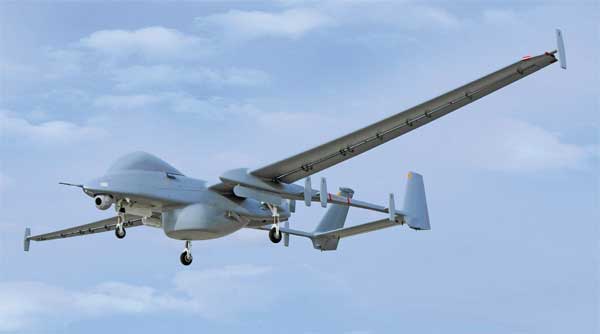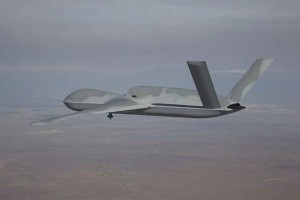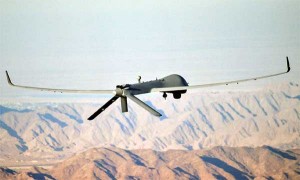Land and Sea Systems
Apart from aerial systems, the DRDO is tasked with developing the full range of unmanned military capability of the three services. The Combat Vehicles Research and Development Establishment (CVRDE), a DRDO laboratory, is developing various Unmanned Ground Vehicles (UGV) under its Muntra project. Muntra-S is a rugged BMP II vehicle-based system that can carry out surveillance of ground targets spread over a widely dispersed conflict zone. Muntra-N is designed for Nuclear, Biological and Chemical (NBC) reconnaissance and Muntra-M is intended for mine detection missions. The battle proven BMP II class of tracked armoured vehicles have an inherent amphibious capability, thus making these UGVs highly potent and versatile unmanned platforms.
India is likely to procure more than 5,000 UAVs over the next ten years at a cost of over $3 billion…
Then there is the Daksh, designed for the delicate and dangerous task of bomb disposal. It is an electrically powered and remotely operated wheeled vehicle used for locating, handling and destroying hazardous objects safely. Capable of being remotely controlled over a range of 500m Line-Of-Sight (LOS) or even within buildings, it is an important asset in the hands of the Indian Army, Police and Paramilitary Forces.
The Indian Navy too needs unmanned craft. Apart from surface vessels, Unmanned Underwater Vehicles (UUV) are invaluable for Mine Counter-Measure (MCM) operations, naval ISR roles and Anti-Submarine Warfare (ASW) missions. There are two broad types of UUVs: Autonomous Undersea Vehicles (AUVs) that can operate independently without human inputs for most or all phases of operation and Remotely Operated-undersea Vehicles (ROVs) where a human operator is essential. UUVs have the potential to revolutionise naval warfare just as UAVs are transforming air-land warfare.
The Naval Science and Technological Laboratory (NSTL), Visakhapatnam, under the DRDO, is developing various AUVs small and large. It is currently working on an AUV that is four metres long, 1.4m wide, weighs 1,500kg and can take a 500kg payload. It has a speed of about seven kmph and a depth rating of 400m. According to NSTL, with the completion of user evaluation trials, the AUV’s basic design is ready. Work on the customised design will commence once the Indian Navy finalises its Qualitative Requirements (QRs). The Indian Navy is expected to order ten such AUVs for ISR, mine mitigation and sensor deployment, communication couriers and for target practice during exercises.
The Inevitability of Imports
As with most weapon systems of the three services, the process of induction of UAVs began with imports. The Indian Army was first off the blocks in 1996, when it began operating the Searcher Mk I tactical surveillance UAV acquired from Israel Aerospace Industries (IAI). The IAF and the Indian Navy quickly followed suit. By 2000, the Searcher Mk II entered service and a year later the Heron 1 MALE UAV. Both these systems are also manufactured by IAI. The pace of induction has been very slow. Between them, the three services have only about 100 Searcher Mk IIs, while 50 to 60 Heron 1s are shared between the IAF and the Indian Navy.
The Indian armed forces plan to induct over 200 armament-capable UAVs in the next ten years…
However, for the last year or two, the outlook has been rapidly improving, because of increased government commitment as well as its June 2016 decision to join the Missile Technology Control Regime (MTCR). Some estimates are that India is likely to procure more than 5,000 UAVs over the next ten years at a cost of over $3 billion. These include High Altitude Long Endurance (HALE) UAVs, MALE UAVs, Vertical Take-Off and Landing (VTOL) UAVs and tactical UAVs going all the way down to mini- and micro-UAVs for the Indian Army. The Army proposes to provision UAVs even at the battalion level. In November 2016, the high-powered Defence Acquisition Council (DAC) approved the purchase of 598 mini-UAVs for the infantry, under the ‘Buy Indian’ category. According to official sources, they will be used for aerial surveillance of areas up to five to seven kilometres ahead of the area of responsibility.
The IAF and the Indian Navy will also have several squadrons each of surveillance UAVs and UCAVs. It is estimated that the Indian armed forces plan to induct over 200 armament-capable UAVs in the next ten years. In November 2016, the Indian government signed a $400-million deal to purchase ten IAI Heron TP UAVs (also known as Eitan) for the IAF. Delivery is expected to commence within two to three years. This will give the country its first known capability to launch guided weapons and lightweight air-to-ground tactical missiles from an unmanned platform. It will be an invaluable asset should more cross-border surgical strikes be planned.
The Heron TP has a wingspan of 26m and length of 14m. According to the manufacturer, it has a maximum take-off weight of 4,650kg and carries a typical mission payload of 1,000kg. It is powered by a 1,200 HP turboprop engine and has an impressive endurance of 36 hours. Its range is Beyond Line of Sight (BLOS) with SATCOM.
Of even greater importance is the possibility that India will purchase advanced UAVs and UCAVs from the US. Most likely to be inducted are 22 Predator XP unarmed UAVs for the Indian Navy. The IAF is looking to purchase 100 General Atomics Predator C Avenger next generation, multi-mission UCAVs. This would make India the largest operator of this UCAV in the world. The jet-powered Avenger has a length of 13m and wingspan of 20m. Its maximum take-off weight is 8,255kg. Its internal and total payload capacity is 1,588kg and 2,948kg respectively. It has several stealth features including reduced radar and heat signature as well as internal weapons storage.
To encourage a future that will be less dependent on the DRDO, many major UAV systems can be outsourced to competent and qualified Indian firms…
Are all these proposed acquisitions part of a plan? They are. Since getting enough combat aircraft is proving such a daunting task and may take perhaps a couple of decades, military planners are trying to quickly increase the IAF’s firepower through armed UAVs and UCAVs. These may also be more suitable than manned combat jets for the no-war no-peace situation that prevails along India’s western border. They would be the system of choice to take out terrorist camps or infrastructure and might lead the first wave against enemy air defence systems or vital targets deep inside enemy territory in the event of an all-out war.
A Brighter Unmanned Future Depends on the Private Sector
Of late, the Indian government has renewed its efforts to make up for lost time and manufacture or import various types of unmanned systems in large numbers, realising that they will be an important factor in any future conflict. There is a crying need for the DRDO to be more realistic in its claims of successes and rosy projections for the future, as well as more reliable in its development time and cost estimates. Critical technologies necessary for UAV operation cannot be developed overnight. For instance, key to safe aerial unmanned operations outside of military airspace is a compact and foolproof collision avoidance system and this is still not available indigenously. The Tapas 201 (Rustom-2) is the first really capable UAV to emerge from DRDO’s stable. Its speedy readiness and smooth induction in the Indian military could mark a turning point in DRDO’s performance. But key to the process will be the organisation’s ability to stick to deadlines and cost estimates as well as to deliver a product of impeccable quality.
Further in the future is DRDO’s Autonomous Unmanned Research Aircraft (AURA) for the IAF and the Indian Navy. The design work is to be carried out by the Aeronautical Development Agency (ADA). AURA is planned as a stealthy UCAV, capable of internal and external weapon carriage. Currently, almost the entire inventory of the nation’s operational UAVs is imported. There is a growing realisation that unless the private sector is involved in a big way, it will be impossible to even partially satisfy the demand for military unmanned systems through indigenous sources.
…unless the private sector is involved in a big way, it will be impossible to even partially satisfy the demand for military unmanned systems through indigenous sources…
To encourage a future that will be less dependent on the DRDO, many major UAV systems can be outsourced to competent and qualified Indian firms. It is heartening that various systems of the Tapas 201 such as the airframe, landing gear and sub-systems for flight control and avionics, were developed within the country with the collaboration of private industries. According to Tata Advanced Systems Ltd (TASL), the firm is well-positioned to build entire aircraft and UAVs for defence customers under the ‘Make in India’ programme. Reliance Defence and L&T Heavy Engineering too are quite capable of developing and manufacturing small UAVs on their own and they can gradually move up the value chain. Therefore, even for imports, tenders are to be restricted to domestic companies that can tie up with foreign firms to ‘Make in India’.
India’s holdings of unmanned systems are clearly inadequate for a country of this size. This is, perhaps, due to uncertain commitment from the users in the past, inadequate funding and over-reliance on the DRDO’s ability to deliver. Consequently, precious time has been lost. Pakistan is well on the way to acquiring a respectable unmanned military capability with assured help from China. China itself has forged so far ahead that India has no realistic hope of matching its capability in the foreseeable future. Concerted efforts are, therefore, necessary to equip the country’s armed forces with adequate UAVs and other unmanned systems for critical ISR tasks as well as to meet the threat of cross-border terrorist attacks. It will help them better address the complex security challenges the country faces.








DRDO really fill us proud & I proudly says that we live in a country to be prooud. Thanks DRDO we really proud of you. Thank You Soooooooooooooooomuch